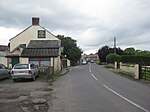Tealham and Tadham Moors

Tealham and Tadham Moors (grid reference ST420450) is a 917.6 hectare (2267.3 acre) biological Site of Special Scientific Interest south of Wedmore in Somerset, notified in 1985. Land south of this site is included in Catcott, Edington and Chilton Moors SSSI. Tealham and Tadham Moors form part of the extensive grazing marsh and ditch systems of the Somerset Levels and Moors. The water table is high throughout the greater part of the year with winter flooding occurring annually, by over-topping of the River Brue. 113 aquatic and bankside vascular plant species have been recorded from the field ditches, rhynes and deep arterial watercourses. A diverse invertebrate fauna is associated in particular with ditches that have a good submerged plant community. The water beetle fauna is exceptionally rich, with the nationally rare species Hydrophilus piceus and Hydrochara caraboides together with the rare soldier flies Stratiomys furcata and Odontomyia ornata. Good numbers of dragonflies and damselflies occur including the Hairy Dragonfly (Brachytron pratense) and the Variable Damselfly (Coenagrion pulchellum).
Excerpt from the Wikipedia article Tealham and Tadham Moors (License: CC BY-SA 3.0, Authors, Images).Tealham and Tadham Moors
Burnt Drove,
Geographical coordinates (GPS) Address Nearby Places Show on map
Geographical coordinates (GPS)
| Latitude | Longitude |
|---|---|
| N 51.20125 ° | E -2.83153 ° |
Address
Burnt Drove
Burnt Drove
BS28 4UD
England, United Kingdom
Open on Google Maps











